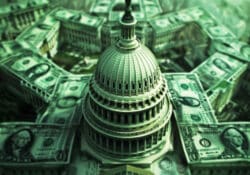
“The Great Taking”: How They Can Own It All
by Ellen Brown| Oct 3, 2023
“’You’ll own nothing and be happy’? David Webb has gone through the 50-year history of all the legal constructs that have been put in place to technically enable that to happen.”
The derivatives bubble has been estimated to exceed one quadrillion dollars (a quadrillion is 1,000 trillion). The entire GDP of the world is estimated at $105 trillion, or 10% of one quadrillion; and the collective wealth of the world is an estimated $360 trillion. Clearly, there is not enough collateral anywhere to satisfy all the derivative claims. The majority of derivatives now involve interest rate swaps, and interest rates have shot up. The bubble looks ready to pop.
Who were the intrepid counterparties signing up to take the other side of these risky derivative bets? Initially, it seems, they were banks –led by four mega-banks, JP Morgan Chase, Citibank, Goldman Sachs and Bank of America. But according to a 2023 book called The Great Taking by veteran hedge fund manager David Rogers Webb, counterparty risk on all of these bets is ultimately assumed by an entity called the Depository Trust & Clearing Corporation (DTCC), through its nominee Cede & Co. (See also Greg Morse, “Who Owns America? Cede & DTCC,” and A. Freed, “Who Really Owns Your Money? Part I, The DTCC”). Cede & Co. is now the owner of record of all of our stocks, bonds, digitized securities, mortgages, and more; and it is seriously under-capitalized, holding capital of only $3.5 billion, clearly not enough to satisfy all the potential derivative claims. Webb thinks this is intentional.
What happens if the DTCC goes bankrupt? Under The Bankruptcy Abuse Prevention and Consumer Protection Act (BAPCPA) of 2005, derivatives have “super-priority” in bankruptcy. (The BAPCPA actually protects the banks and derivative claimants rather than consumers; it was the same act that eliminated bankruptcy protection for students.) Derivative claimants don’t even need to go through the bankruptcy court but can simply nab the collateral from the bankrupt estate, leaving nothing for the other secured creditors (including state and local governments) or the banks’ unsecured creditors (including us, the depositors). And in this case the “bankrupt estate” – the holdings of the DTCC/Cede & Co. – includes all of our stocks, bonds, digitized securities, mortgages, and more.
It sounds like conspiracy theory, but it’s all laid out in the Uniform Commercial Code (UCC), tested in precedent, and validated by court rulings. The UCC is a privately-established set of standardized rules for transacting business, which has been ratified by all 50 states and includes key provisions that have been “harmonized” with the laws of other countries in the Western orbit. The UCC makes boring reading and is anything but clear, but Webb has diligently picked through the obscure legalese and demonstrates that the amorphous “they” have it all locked up. They can take everything in one fell swoop, without even going to court. Ideally, we need to get Congress to modify some laws, beginning with the super-priority provisions of the Bankruptcy Law of 2005. Even billionaires, notes Webb, are at risk of losing their holdings; and they have the clout to take action.
About The Great Taking and Its Author
As detailed in the introduction, “David Rogers Webb has deep experience with investigation and analysis within challenging and deceptive environments, including the mergers and acquisitions boom of the 80’s, venture investing, and the public financial markets. He managed hedge funds through the period spanning the extremes of the dot-com bubble and bust, producing a gross return of more than 320% while the S&P 500 and the NASDAQ indices had losses. His clients included some of the largest international institutional investors.”
A lengthy personal preface to the book not only establishes these bona fides but tells an interesting story concerning his family history and the rise and fall of his home city of Cleveland in the Great Depression.
As for what the book is about, Webb summarizes in the introduction:
It is about the taking of collateral (all of it), the end game of the current globally synchronous debt accumulation super cycle. This scheme is being executed by long-planned, intelligent design, the audacity and scope of which is difficult for the mind to encompass. Included are all financial assets and bank deposits, all stocks and bonds; and hence, all underlying property of all public corporations, including all inventories, plant and equipment; land, mineral deposits, inventions and intellectual property. Privately owned personal and real property financed with any amount of debt will likewise be taken, as will the assets of privately owned businesses which have been financed with debt. If even partially successful, this will be the greatest conquest and subjugation in world history.
You might have to read the book to be convinced, but it is not long, is available below and is heavily referenced and footnoted. I will try to summarize his main points, but first a look at the derivatives problem and how it got out of hand.
The Derivative Mushroom Cloud
A “financial derivative” is defined as “a security whose value depends on, or is derived from, an underlying asset or assets. The derivative represents a contract between two or more parties and its price fluctuates according to the value of the asset from which it is derived.”
Warren Buffett famously described derivatives as “weapons of financial mass destruction,” but they did not start out that way. Initially they were a form of insurance for farmers to guarantee the price of their forthcoming crops. In a typical futures contract, the miller would pay a fixed price for wheat not yet harvested. The miller assumed the risk that the crops would fail or market prices would fall, while the farmer assumed the risk that prices would rise, limiting his potential profit.
In either case, the farmer actually delivered the product, or so much of it as he produced. The derivatives market exploded when speculators were allowed to bet on the rise or fall of prices, exchange rates, interest rates and other “underlying assets” without actually owning or delivering the “underlying.” Like at a race track, bets could be placed without owning the horse, so there was no limit to the potential number of bets. Speculators could “hedge their bets” by selling short — borrowing and selling stock or other assets they did not actually own. It was a form of counterfeiting that not only diluted the value of the “real” stock but drove down the stock’s price, in many cases driving the company into bankruptcy, so that the short sellers did not have to cover or “deliver” at all (called “naked shorting”). This form of gambling was allowed and encouraged due to a number of regulatory changes, including the Commodity Futures Modernization Act of 2000 (CFMA), repealing key portions of the Glass-Steagall Act separating commercial from investment banking; the Bankruptcy Law of 2005, guaranteeing recovery for derivative speculators; and the lifting of the uptick rule, which had allowed short selling only when a stock was going up.
Enter the DTC, the DTCC and Cede & Co.
In exchange-traded derivatives, a third party, called a clearinghouse, ensures that the bets are paid, a role played initially by the bank. And here’s where the UCC and the DTCC come in. The bank takes title in “street name” and pools it with other “fungible” shares. Under the UCC, the purchaser of the stock does not hold title; he has only a “security entitlement”, making him an unsecured creditor. He has a contractual claim to a portion of a pool of shares held in street name, assuming there are any shares left after the secured creditors have swept in. Webb writes:
In the late 1960’s, something called the Banking and Securities Industry Committee (BASIC) had been formed to find a solution to the “paperwork crisis.” It seemed the burdens of handling physical stock certificates had suddenly become too great, so much so, that the New York Stock exchange had suspended trading some days. “Lawmakers” then urged the government to step into the process. The BASIC report recommended changing from processing physical stock certificates to “book-entry” transfers of ownership via computerized entries in a trust company that would hold the underlying certificates “immobilized.”
Thus was established the Depository Trust Company (DTC), which began operations in 1973, after President Nixon decoupled the dollar from gold internationally. The DTC decoupled stock ownership from paper stock certificates. The purchasers who had put up the money became only “beneficial owners” entitled to interest, dividends and voting rights, leaving title of record in the DTC. The Depository Trust and Clearing Corporation (DTCC) was established in 1999 to combine the functions of the DTC and the National Securities Clearing Corporation (NSCC). The DTCC settles most securities transactions in the U.S. Title of record is with DTC’s nominee Cede & Co. Per Wikipedia:
Cede and Company (also known as Cede and Co. or Cede & Co.), shorthand for “certificate depository”, is a specialist United States financial institution that processes transfers of stock certificates on behalf of Depository Trust Company, the central securities depository used by the United States National Market System, which includes the New York Stock Exchange, and Nasdaq.
Cede technically owns most of the publicly issued stock in the United States. Thus, most investors do not themselves hold direct property rights in stock, but rather have contractual rights that are part of a chain of contractual rights involving Cede. Securities held at Depository Trust Company are registered in its nominee name, Cede & Co., and recorded on its books in the name of the brokerage firm through which they were purchased; on the brokerage firm’s books they are assigned to the accounts of their beneficial owners. [Emphasis added.]
Greg Morse notes that the dictionary definition of “cede” is to “relinquish title.”
“Harmonizing” the Rules
The next step in the decoupling process was to establish “legal certainty” that the “anointed” creditors could take all, by amending the UCC in all 50 states. This was done quietly over many years, without an act of Congress. The key facts, notes Webb, are these:
- Ownership of securities as property has been replaced with a new legal concept of a “security entitlement”, which is a contractual claim assuring a very weak position if the account provider [bank/clearing agent] becomes insolvent.
- All securities are held in un-segregated pooled form. Securities used as collateral, and those restricted from such use, are held in the same pool.
- All account holders, including those who have prohibited use of their securities as collateral, must, by law, receive only a pro-rata share of residual assets.
- “Re-vindication,” i.e. the taking back of one’s own securities in the event of insolvency, is absolutely prohibited.
- Account providers may legally borrow pooled securities to collateralize proprietary trading and financing.
- “Safe Harbor” assures secured creditors priority claim to pooled securities ahead of account holders.
- The absolute priority claim of secured creditors to pooled client securities has been upheld by the courts.
The next step was to “harmonize” the laws internationally so that there would be no escape, at least in the Western orbit. Webb learned this by personal experience, having moved to Sweden to escape, only to have Swedish law subsequently “harmonized” with the “legal certainty” provisions of the UCC.
“Safe Harbor” in the Bankruptcy Code
The last step was to establish “safe harbor” in the 2005 Bankruptcy Code revisions – meaning “’safe harbor’ for secured creditors against the demands of customers to their own assets.” Webb quotes from law professor Stephen Lubben’s book The Bankruptcy Code Without Safe Harbors:
Following the 2005 amendments to the Code, it is hard to envision a derivative that is not subject to special treatment. The safe harbors cover a wide range of contracts that might be considered derivatives, including securities contracts, commodities contracts, forward contracts, repurchase agreements, and, most importantly, swap agreements. …
The safe harbors as currently enacted were promoted by the derivatives industry as necessary measures . . . The systemic risk argument for the safe harbors is based on the belief that the inability to close out a derivative position because of the automatic stay would cause a daisy chain of failure amongst financial institutions. The problem with this argument is that it fails to consider the risks created by the rush to close out positions and demand collateral from distressed firms. Not only does this contribute to the failure of an already weakened financial firm, by fostering a run on the firm, but it also has consequent effects on the markets generally . . . the Code will have to guard against attempts to grab massive amounts of collateral on the eve of a bankruptcy, in a way that is unrelated to the underlying value of the trades being collateralized.
A number of researchers have found that super-priority in bankruptcy for derivatives actually increases rather than decreases risk. See e.g. a National Bureau of Economic Research paper called “Should Derivatives be Privileged in Bankruptcy?” Among other hazards, super-priority has contributed to the explosion in speculative derivatives, threatening the stability of national and global markets. For more on this issue, see my earlier articles here and here.
What to Do?
Webb does not say much about solutions; his goal seems to be to sound the alarm. What can we do to protect our assets? “Probably nothing,” he quoted a knowledgeable expert in a recent webinar. “We just have to stop them.” But he did point out that even the assets of the wealthy are threatened. If the issue can be brought to the attention of Congress, hopefully they can be motivated to revise the laws. Congressional action could include modifying the Bankruptcy Act of 2005 and the UCC, taxing windfall profits, imposing a financial transaction tax, and enforcing the antitrust laws and Constitutional property rights. As for timing, Webb says just the movement in interest rates, from 0.25% to 5.5%, should have collapsed the market already. He thinks it is being held up artificially, while “they” get the necessary systems in place.
Where to save your personal monies? Big derivative banks are risky, and Webb thinks credit unions and smaller banks will go down with the market if there is a general collapse, as happened in the Great Depression. Gold and silver are good but hard to spend on groceries. Keeping some emergency cash on hand is important, and so is growing your own food if you have space for a garden. Short-term Treasuries bought directly from the government at Treasury Direct might be the safest savings option, assuming the government doesn’t wind up in bankruptcy itself.
Meanwhile, we need to design an alternative financial system that is equitable and sustainable. Promising components might include publicly-owned banks, product-backed community cryptocurrencies, a land value tax, and a financial transaction tax.
A neoliberal, financialized economy of the sort we have today produces little and leaves the workers in debt. Goods and services are produced by the “real” economy; finance is just superstructure. Derivatives do not now produce even the security for which they were originally intended. A healthy, enduring economy must produce real things and exchange them fairly for the wages earned by labor.
Subscribe to World of Debt Blog




